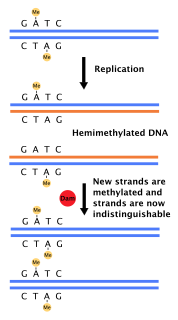
Yersinia pestis is a gram-negative, non-motile, coccobacillus bacterium, without spores that is related to both Yersinia pseudotuberculosis and Yersinia enterocolitica. It is a facultative anaerobic organism that can infect humans via the Oriental rat flea. It causes the disease plague, which caused the First plague pandemic and the Black Death, the deadliest pandemic in recorded history. Plague takes three main forms: pneumonic, septicemic, and bubonic.

Yersinia is a genus of bacteria in the family Yersiniaceae. Yersinia species are Gram-negative, coccobacilli bacteria, a few micrometers long and fractions of a micrometer in diameter, and are facultative anaerobes. Some members of Yersinia are pathogenic in humans; in particular, Y. pestis is the causative agent of the plague. Rodents are the natural reservoirs of Yersinia; less frequently, other mammals serve as the host. Infection may occur either through blood or in an alimentary fashion, occasionally via consumption of food products contaminated with infected urine or feces.

Yersinia enterocolitica is a Gram-negative, bacillus-shaped bacterium, belonging to the family Yersiniaceae. It is motile at temperatures of 22–29°C (72–84°F), but becomes nonmotile at normal human body temperature. Y. enterocolitica infection causes the disease yersiniosis, which is an animal-borne disease occurring in humans, as well as in a wide array of animals such as cattle, deer, pigs, and birds. Many of these animals recover from the disease and become carriers; these are potential sources of contagion despite showing no signs of disease. The bacterium infects the host by sticking to its cells using trimeric autotransporter adhesins.

Yersinia pseudotuberculosis is a Gram-negative bacterium that causes Far East scarlet-like fever in humans, who occasionally get infected zoonotically, most often through the food-borne route. Animals are also infected by Y. pseudotuberculosis. The bacterium is urease positive.

DNA adenine methylase, (Dam methylase) is an enzyme that adds a methyl group to the adenine of the sequence 5'-GATC-3' in newly synthesized DNA. Immediately after DNA synthesis, the daughter strand remains unmethylated for a short time. It is an orphan methyltransferase that is not part of a restriction-modification system and regulates gene expression. This enzyme catalyses the following chemical reaction

Colitose is a mannose-derived 3,6-dideoxysugar produced by certain bacteria. It is a constituent of the lipopolysaccharide.

Dual specificity mitogen-activated protein kinase kinase 3 is an enzyme that in humans is encoded by the MAP2K3 gene.

Yersiniabactin (Ybt) is a siderophore found in the pathogenic bacteria Yersinia pestis, Yersinia pseudotuberculosis, and Yersinia enterocolitica, as well as several strains of enterobacteria including enteropathogenic Escherichia coli and Salmonella enterica. Siderophores, compounds of low molecular mass with high affinities for ferric iron, are important virulence factors in pathogenic bacteria. Iron—an essential element for life used for such cellular processes as respiration and DNA replication—is extensively chelated by host proteins like lactoferrin and ferritin; thus, the pathogen produces molecules with an even higher affinity for Fe3+ than these proteins in order to acquire sufficient iron for growth. As a part of such an iron-uptake system, yersiniabactin plays an important role in pathogenicity of Y. pestis, Y. pseudotuberculosis, and Y. entercolitica.

In molecular biology, YadA is a protein domain which is short for Yersinia adhesin A. These proteins have strong sequence and structural homology, particularly at their C-terminal end. The function is to promote their pathogenicity and virulence in host cells, though cell adhesion. YadA is found in three pathogenic species of Yersinia, Y. pestis,Y. pseudotuberculosis, and Y. enterocolitica. The YadA domain is encoded for by a virulence plasmid in Yersinia, which encodes a type-III secretion (T3S) system consisting of the Ysc injectisome and the Yop effectors.
Yersinia virus L413C is a virus of the family Myoviridae, genus Peduovirus.
Far East scarlet-like fever is an infectious disease caused by the gram negative bacillus Yersinia pseudotuberculosis. In Japan it is called Izumi fever.
CDP-abequose synthase (EC 1.1.1.341, rfbJ (gene)) is an enzyme with systematic name CDP-alpha-D-abequose:NADP+ 4-oxidoreductase. This enzyme catalyses the following chemical reaction
Yersinia kristensenii is a species of bacteria. It is Gram-negative and its type strain is 105. It is potentially infectious to mice. It secretes a bacteriocin that targets related species.
Yersinia intermedia is a Gram-negative species of bacteria which uses rhamnose, melibiose, and raffinose. Its type strain is strain 3953. It has been found in fish, and contains several biotypes. It is not considered of clinical relevance, being isolated from humans in a routine manner.
Yersinia aldovae is a species of bacteria that was originally described as Group X2 Yersinia enterocolitica. Its type strain is CNY 6005. Y. aldovae has been isolated from aquatic environments and soil, but it has not been associated with animal or human illnesses.
Pasteurella lymphangitidis is a bacterium; it causes bovine lymphangitis. Its reclassification to Yersinia has been proposed, given it poses a 99% sequence similarity to both Yersinia pseudotuberculosis and Yersinia pestis.
Yersinia mollaretii is a Gram-negative species of bacteria. The species is named after Henri Mollaret, the former head of the National Yersinia Center at Institut Pasteur.
Yersinia similis is a Gram-negative bacteria species of Yersinia that resembles Yersinia pseudotuberculosis phenotypically but differs on the basis of 16S ribosomal RNA sequences. The type strain Y228 was originally isolated from a rabbit in Germany.







